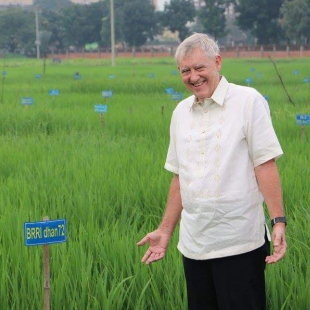As terrible as the direct effects of COVID have been and continue to be, the indirect effects on malnutrition in low-income settings over the next several years will be severe as well. Incomes will likely decline and food prices rise over time. The result will be worsening dietary quality.
The implications are clear: we need to take action to mitigate, as much as possible, these predicted negative consequences for nutrition. Now.
But we also need to consider constraints and priorities. For while we know what can be effective in tackling malnutrition, the delivery of nutrition interventions is threatened by lack of funding. Tax revenues will fall and direct spending on the COVID-19 response is a new and unavoidable demand on government spending. Moreover, there are constraints in implementation given mobility restrictions and related limitations during COVID response and recovery. So to make the best decisions and work within the limited budgets that exist, there is a need to predict the coming changes and then plan out what can be done now, and what we will be able to do later. In this blog, I set out what I think the key changes will be in the COVID-19 response and recovery phase and how this is likely to affect the delivery of nutrition interventions.
I anticipate there will be five phases of response and recovery setout below and in Chart 1 (1). Developed primarily for low income settings, these will be shaped by mobility restrictions due to lockdown, mass availability of vaccines, and time it takes to re-achieve 2019 levels of economic output and employment. Key economic parameters – resources available to governments for nutrition and health programmes, household incomes, and food prices – will also play a key role.

Phase 1. Still on Significant Lockdown: This is the most severe – mobility being very restricted at multiple levels, with rapidly rising unemployment, declines in GDP and increases in poverty.
Phase 2. Lockdown Restrictions Gradually Reduced: In this phase, domestic economies will begin to operate but not as efficiently because of the necessity to contain secondary outbreaks of COVID, unemployment will begin to improve but will remain high and poverty will remain higher than pre-COVID. Nutrition and health workers (among others) will have concerns about contracting COVID while working on the job, and will take precautions. Governments will still be spending significant amounts to contain COVID, yet tax receipts will have fallen. International trade will continue to be restricted due to difficulties of international travel and the unevenness of the control of COVID across countries.
Phase 3. Mass Quantities of Vaccinations Made Available: Recovery of developed country economies begins in earnest in Phase 3. International trade will pick up. Low income countries will still be in Phase 2 at this stage and restrictions on mobility and trade between high-income and low-income countries will remain in place to some extent. Planning will become much easier because there is clear knowledge about the availability of vaccines.
Phase 4. Significant Economic Recovery Begins: In Phase 4, employment and economic output re-achieve pre-COVID levels. Low-income countries, last in line to receive the vaccine, will administer the vaccine widely and spending to contain COVID and on safety net programmes will decline dramatically. Economic growth rates may be high, but resources for nutrition and health programmes are still constrained as compared with pre-COVID.
Phase 5. Strong Economic Growth Returns at Pre-COVID Levels
With regard to food prices, lower incomes during the first four phases will mean food demand (especially for non-staple foods) is likely to decline. In Phase 1, if mobility restrictions mean harvested foods do not reach the market or are subject to losses, prices may rise but the situation is likely to be very mixed since in many cases they will reach markets. What happens to supplies in phase 2 is critical. Will farmers want to take the risk of investing inputs in the same level of supply? Can they get access to inputs as before (seed, fertiliser, credit)? While mobility will be increasingly easier in subsequent phases, possible food price rises will depend on policies undertaken in each country on a case by case basis. Before COVID-19 there already were longer-run pressures for non-staple food prices to rise faster than staple food prices. Government attention to staple food prices under the pandemic and COVID-19 related restrictions on input and output markets for non-staple foods, will likely only serve to exacerbate this disparity.

The characteristics of each of the phases have important implications for nutrition interventions, including social protection programmes, direct nutrition interventions, and agriculture and food system interventions. In addition to potential disruptions and responses set out below, Chart 2(2) sets out further constraints on nutrition interventions by phase.
- Firstly, social safety net programmes. Governments have been spending very significant amounts on such programmes to protect, in a partial way, the newly unemployed. Costs may be reduced over time as some of the unemployed are able to return to work, but in general they will continue until a vaccine is implemented and pre-COVID levels of economic activity return. Governments are, after all, aware of the political importance of these social safety nets.
- The second set are direct nutrition interventions. For example, recommendations for temporary suspension of preschooler vitamin A supplementation programmes have already been made due to restricted mobility. The ability for health workers who administer these programmes to get going again will depend on if they feel safe and have the requisite personal protective equipment – and the extent to which resumption of programs at possibly higher costs is constrained by Health Ministry budgets. Fortification is another intervention that can boost micronutrient intake. If conducted primarily by the private sector, this could carry on as before – but not if supplies are interrupted by trade restrictions or if subsidies by now cash-strapped heath ministries stop. Behaviour and social change programmes are another nutrition intervention that will be affected if they require face-to-face interaction. There will be the added constraint of health workers and parents worried about contracting COVID and the cost of having extra protection – unless the programmes can be accomplished effectively via remote means.
- The third set of vital nutrition interventions are those that simply aim to keep agriculture and food systems operating so people can eat nutritious foods. COVID-19 restrictions are bound to make these operations more challenging. While governments will likely give priority to keeping food staple prices low, there is an opportunity to introduce more nutrition-focused interventions. For example, where biofortified crops have already been released and initial seed multiplication has been accomplished, emergencies can be a spur to adoption of new seeds. Or, governments may choose one or two key non-staple foods which are overwhelmingly important for nutrition in their particular setting – for example, milk in India – and promote supply and availability all along the value chain, keeping the price as low as possible.
Overall, severe budget constraints will be the new reality during COVID-19 response and recovery for nutrition interventions, given the need to allocate spending to the COVID-19 response. National tax revenues will be lower and governments will not be able to do more with less. Here I have provided a suggested framework to help decision-makers make the right choices. But this must be a collectively determined path. A process that provides the rationale for prioritisation among the most cost-effective and affordable nutrition interventions is vital.
Howarth E. "Howdy" Bouis is an American economist whose work has focused on agriculture, nutrition outcomes, and reducing micronutrient malnutrition. He is the founder and former director of HarvestPlus and Emeritus Fellow at the International Food Policy Research Institute (IFPRI). In 2016, he was one of the recipients of the World Food Prize for his work on biofortification. Learn more.

